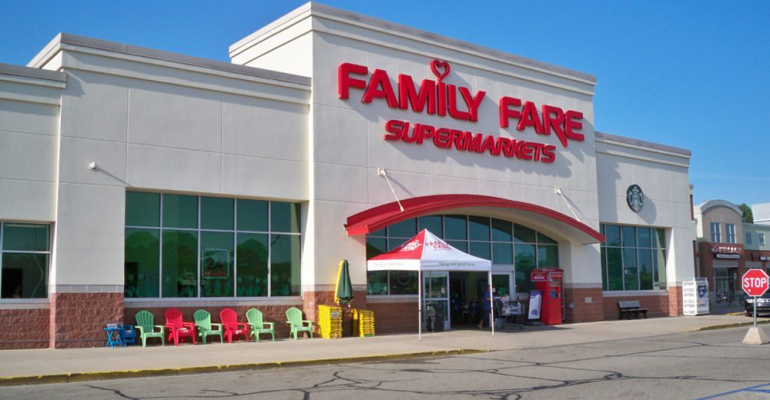SpartanNash reported decreased sales across its business segments in its fiscal 2021 first quarter as the grocery distributor and retailer came up against last year’s big sales gains driven by the COVID-19 pandemic.
For the 16-week quarter ended April 24, net sales totaled $2.66 billion, down 7% from $2.86 billion a year earlier, SpartanNash said yesterday after the market close. The Grand Rapids, Mich.-based company attributed the decline to favorable prior-year sales fueled by pandemic-related consumer demand, which had lifted sales 12.4% year over year.
Growth with certain food distribution customers partially offset lower sales in the 2021 quarter, while COVID-related restrictions on domestic base access and commissary shopping continued to negatively impact military distribution sales, SpartanNash added.

“This is a transitional quarter for SpartanNash. Our overall profitability is on track with our expectations at the start of the year, although the results across the business segments were somewhat mixed. We knew this was going to be a challenging quarter on the top line [given] last year’s pandemic surge that our industry experienced in March and April 2020,” President and CEO Tony Sarsam (left) told analysts in a conference call on Thursday morning. “In addition, we delivered gross margin expansion of 90 basis points for our total company, which included improvements in each of our business segments,” he added.
In the core food distribution segment, first-quarter net sales dipped 2.6% to $1.33 billion from $1.37 billion a year ago, when SpartanNash recorded a 17.1% gain. But going back beyond the pandemic-driven sales spike, food distribution sales in the 2021 quarter were up 14% versus the 2019 first quarter, according to SpartanNash.
“In addition to the year-over-year impact of lapping the pandemic, sales were also lower due to the exit of our fresh production business, which operated for a portion of last year’s first quarter,” Chief Financial Officer Jason Monaco said in Thursday’s call. “The decrease in sales was partly offset by continued growth with certain existing food distribution customers and our growth pipeline of new business.”
Net sales for the retail business unit came in at $739.4 million, down 5.5% from $782.6 million in the prior-year period, which saw an 11.5% increase. Comparable-store sales fell 7%, following up a 15.6% jump in the 2020 quarter. SpartanNash finished the 2021 first quarter with 154 company-owned supermarkets, versus 155 a year ago, under such banners as Family Fare, Martin’s Super Markets, D&W Fresh Market, VG’s Grocery and Dan’s Supermarket.
“Despite the significant headwind, our retail segment performed particularly well,” Sarsam said. “Comparable-store sales were down 7%, but they’re up significantly on a two-year basis at 9.3%. We were happy to see this trend continue, consistent with how we ended 2020.”
Military distribution net sales dropped 17.1% to $584.3 million from $704.4 million in the 2020 quarter, when the segment posted a 4.9% gain. Besides the tough year-over-year comparison, SpartanNash said base access and commissary shopping restrictions due to COVID-19 continue to weigh heavily on results. On a two-year stack, sales were down 13.1% versus the 2019 first quarter.
“Lower food traffic stemming from these restrictions continues to drive significant declines in domestic commissary sales and our military segment demand,” said Monaco.
At the bottom line, SpartanNash tallied first-quarter 2021 net income of $19.5 million, or 54 cents per diluted share, compared with $15.4 million, or 43 cents per diluted share, a year earlier. Excluding $502 million in after-tax costs, mostly from organizational realignment and severance, adjusted net earnings (continuing operations) were just over $20 million, or 56 cents per diluted share, versus $24.1 million, or 67 cents per diluted share, in the 2020 quarter. The prior-year period included a 24-cents-per-diluted share impact from restructuring and asset impairment costs, operating losses from the Fresh Cut business, pandemic-related expenses and other adjustments.
Analysts, on average, had forecast adjusted earnings per share of 56 cents, with estimates ranging from 50 cents to 61 cents, according to Refinitiv.

SpartanNash's retail comp-store sales are up 9.3% on a two-year stack despite a 7% decrease in the 2021 first quarter.
Looking ahead, Sarsam expects food-at-home sales in 2021 to remain elevated from pre-pandemic levels, even as more Americans get vaccinated against COVID-19 and resume dining out and other activities.
“As the country reopens and people go back to restaurants and their previous habits, that will have a dampening of the growth that we saw in 2020,” he explained. “We’re really pleased with the way things worked for us in the first quarter. I would conclude that many of those habits were sticker than we may have thought. We beat our corporate retail number by about 1%. In the midst of the time frame when restaurants are opening, we’re seeing a little slower return.
“We worked pretty hard on improving our offering in our stores, and we’ve worked hard on our own-brands penetration. We improved our assortment of our own brands and got really nice lift there. We experienced better margins with those products, and we’re still seeing good uptick on that,” Sarsam said. “We’re seeing people are still buying more online. So our e-commerce business is still doing very well and continues to grow, even in this period of time when the pandemic is waning, so to speak. So some of the things we did to strengthen our business — the own brands, the improved offering in the fresh part of our business and some other elements like e-commerce — I think all those work together to help keep some of those habits I mentioned a little stickier than we might have forecasted.”
SpartanNash projects fiscal 2021 (52 weeks) reported EPS of $1.48 to $1.67 and adjusted EPS of $1.65 to $1.80, compared with fiscal 2020 (53 weeks) actual results of $2.12 and $2.53, respectively.
Analysts’ consensus estimate is for full-year 2021 adjusted EPS of $1.76, with projections running from $1.69 to $1.95, according to Refinitiv.
“We are reaffirming our full-year 2021 guidance. However, we expect a shift in the segment performance from a sales perspective,” Monaco said. “While total sales are expected to remain between $8.8 billion and $9 billion, we now expect that retail comparable sales will be down from 5% to 7% to the prior year, an increase of 1% from our initial expectations. Military sales are now expected to decline between 6% and 10% from the prior year, a further decline from initial expectations. We continue to expect that food distribution sales will be down 1% to 3% from last year. These updates reflect both the trends observed in the [2021 first] quarter, as well as our updated expectations for the remainder of the year.”





